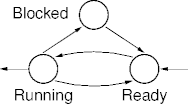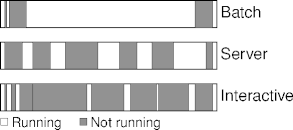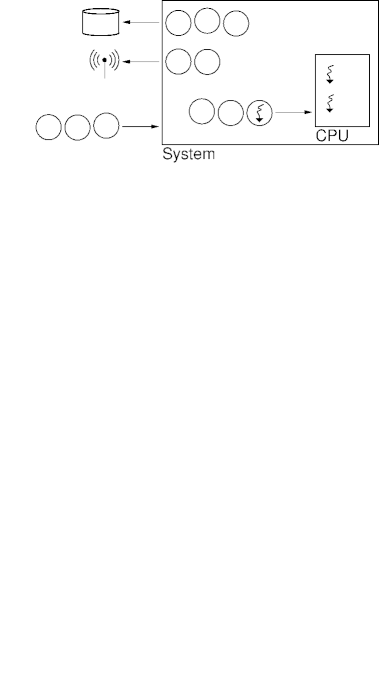Operating Systems Lecture Notes
8 February 2012 • Scheduling
Outline
- Scheduling mechanisms.
- Scheduling strategy.
- Eviction and selection strategies.
- Implementation details.
- Examples
The Story So Far
- A system accepts processes and runs them until they're done.

- The system and processes should behave in desirable ways.
- Processes should move through the system as quickly as possible.
- All parts of the system should be busy all the time.
Promises
- The operating system magically multiplies system facilities.
- Threads and the virtual CPU.
- The operating system provides an imaginary environment for processes.
- An isolated process running in its own system.
- The operating system provides dials a process uses to manipulate its environment.
The Problem
- How should the system and processes be managed to behave properly?
- How should the operating system fulfill its promises?
- How should the conflict between the previous two questions be resolved?
- The scheduler plays a large part in answering these questions.
A Simple Solution
- The simplest possible answer to these questions is to admit one process
at a time.

- The scheduler admits the next waiting process.
- The process in the system executes until it's done.
- Is this a solution? Is it a good solution?
Analysis
- The simple solution
- solves some problems (virtual machines),
- doesn't solve some problems (system utilization), and
- is unclear on some problems (abstract CPUs).
- A more detailed analysis requires sharper criteria.
Scheduler Criteria
- Schedulers can be judged by how they effect
- overall system performance and
- individual process performance.
- Other, larger criteria (efficiency, convenience, protection).
- Schedulers can also be judged on less (or non-) functional criteria.
- How well a scheduler supports other OS abstractions.
Process Performance Measurements
- Service time is the amount of time needed to complete process execution.
- Wait time is the time between process entry and first process execution.
- Turnaround time is the time between first execution and last execution.
- Response time is the time between IO completion and execution in response.
Process Measures Example
- The one-at-a-time scheduler does well on all process performance
measurements.
- Wait and response times are zero.
- Service and turnaround times are equal.
- That's just ducky. Or is it?
System Performance Measures
- Throughput is the number jobs per second.
- High throughput is good.
- Utilization is the system-busy percentage.
- High utilization is good.
- An average of individual process measures.
- High average responsiveness or low average turnaround.
System Measures Example
- The one-at-a-time scheduler provides poor utilization and poor
throughput.
- Poor throughput is perhaps less obvious than poor utilization.
- But it depends on the processes.
- If processes use everything, then utilization is good.
- If processes are minimal and simple, then throughput is good.
Conflicts Abound
- System and process criteria often conflict.
- The good of the many vs. the good of the few.
- Criteria within a category also frequently conflict.
- Simple vs omnivorous processes and system criteria.
- Schedulers (and operating systems) usually represent these conflicts; they don't resolve them.
Trade-Offs
- Schedulers (and operating systems) usually can't resolve conflict.
- Resolution requires strong (or arbitrary) assumptions.
- Instead, represent trade-offs as dials in the scheduler (and operating
system).
- More informed parties set the dials to trade-off as appropriate.
- Performance tuning, for example.
Understanding Trade-offs
- Lots of good knowledge is necessary for
- representing trade-offs well, and
- making good trade-offs.
- Processes are central to both system and process trade-offs.
- Understanding processes and their behavior becomes important.
Process States
- Processes lead a simple life.

- Blocked: a process is unable run.
- Running: the process is in the CPU.
- Ready: the process can run, but isn't in the CPU.
Process Execution
- From the state diagram, processes spend their lives running and not
running.

- Not running includes blocked and ready.
- A process could be not running for many reasons.
- But usually it's blocked waiting for a resource.
Process Behavior
- Process behavior can be ordered along an activity continuum.

- The continuum extremes are Compute-bound and IO-bound computations.
Simple Scheduling Redux
- The simple process model shows how one-at-a-time scheduling fails
systems:

- Letting in more than one process at a time improves system
throughput.
- Without effecting (too much) system performance.
But Wow
- What does a many-process scheduler have to do?
- Figure out which processes to admit.
- Figure out when to admit them.
- And most importantly, figure out how to recover from the mistakes that
will inevitably occur.
- And figure out how to make fewer, less severe mistakes.
Scheduling Illustrated

Scheduling Levels
- There are at least four levels of scheduling possible:
- Admission (long-term, job) scheduling.
- System (mid-term, process) scheduling.
- Device (short-term) scheduling.
- Thread scheduling.
- There’s lots of other scheduling going on.
- Disk-arm scheduling.
Simplifications
- Ignore (mostly) admission and system scheduling.
- Concentrate on the CPU device scheduler.
- And on the thread scheduler, somewhat.
- The device scheduler works with processes.
- Thread = process, for the most part.

Scheduler Classification
- Schedulers can be classified along two dimensions:
- When they evict the running process: the eviction algorithm.
- How they select the next running process: selection algorithm.
-

- Each choice of an eviction and selection algorithm leads to a scheduler.
Eviction Algorithms
- No eviction algorithm: the scheduler never evicts a running process.
- Actual eviction algorithms fall into two categories:
- Absolute: eviction is well defined, sorta.
- Relative: eviction depends on other entities, usually processes.

No Eviction
- Non-preemptive schedulers don't evict (or preempt) processes.
- Easy to implement.
- Misbehaving processes are a problem.
- The OS may provide tools for cooperative scheduling
-
yield()- Move from CPU to ready queue. -
swap(id)- Swap places with the identified process.
-
Absolute Eviction
- Quantum schedulers evict running processes at regular
intervals.
- Defining “regular” can be tricky.
- The quantum gives the interval size in time.
- Quantum size is an important dial in schedulers and OSs.
- Premature eviction can also usually occur.
- Via cooperative scheduling, or obvious eviction points.
Relative Eviction
- Priority schedulers evict processes to maintain a priority invariant.
- Each process is assigned a comparable value called a priority.
- Priority assignment is another important dial.
- The priority invariant constrains running process relative to
the waiting process.
- For example, the running process priority is no less than any waiting process priority.
Hybrid Eviction
- It's possible to combine various eviction algorithms into a new
algorithm.
- A quantum priority scheduler, for example.
- Combine various versions of the same eviction algorithm.
- Have short-, medium-, and long-quantum processes.
- But now processes have to be assigned to versions.
Selection Algorithms
- Once a process leaves the CPU, which process gets next crack?
- Order the waiting processes into a queue.
- The queue head is the next process.
- Similar to eviction, queue ordering can be relative or absolute.
- No selection (a set of waiting processes) is possible but...
Absolute Selection
- Absolute scheduling imposes a strict (more or less) queue ordering on
waiting processes.
- New processes join at the tail, waiting processes leave at the head.
- Queued processes may leave, when canceled, for example.
Relative Selection
- Relative selection uses the (or perhaps a) priority to order waiting
processes.
- The queue becomes a priority queue.
- Any process satisfying the priority invariant is selected next.
Hybrid Selection
- When several processes satisfy the priority invariant, which one is selected?
- Absolute and relative selection are frequently combined in the same
algorithm.
- Strictly queue same-priority processes.
- Or could rely on a secondary priority.
- A selection algorithm often contains several versions of the same
selection algorithm.
- Queues for high, medium, or low priority processes.
First Come First Serve Scheduling
- Processes gain the CPU in the order they entered the system.
- Treat the ready queue as a queue.
- Usualy no eviction algorithm
FCFS Analysis
- FCFS selection is easy to implement.
- A strict queue and a simple selection algorithm.
- Entry time is a weak property; other, more important properties are ignored.
- Except for “queue fairness,” FCFS selection is unlikely to provide useful results.
Shortest Job Next Scheduling
- Each process declares its expected compute time.
- Order the ready queue by increasing compute time.
- Select the head of the queue.
- This is the process with the shortest estimated execution time.
SJN Analysis
- SJN minimizes average wait time.
- All the processes in front of you have the smallest possible execution times.
- Large duration jobs may be starved.
- Accurate job-duration estimates are hard to make.
Round Robin Scheduling
- Strict queue-order selection, any eviction algorithm.
- Evicted processes go to the end of the queue.
- With voluntary eviction, this is equivalent to FCFS scheduling.
Single Scheduler Problems
- What happens when selection produces several candidate processes?
- Several processes with the same priority, or job time, or deadline.
- One scheduler can’t meet all process expectations.
- And those that try get complicated quickly.
- An OS may support multiple process classes.
- Foreground and background processes, for example.
Multi-Scheduler Systems
- Using two or more schedulers can solve these problems.
- At an increase in complexity and scheduling overhead.
- Multiple schedulers often uses multiple ready queues.
- On scheduler can move processes between queues.
Summary
- Schedulers manage process flow through and within a system.
- Schedulers comprise evection and selection algorithms.
- Different choices of each lead to different schedulers.
- There are many schedulers in a system, and the all (should) coordinate to provide good management.
| This page last modified on 2012 February 8. |
